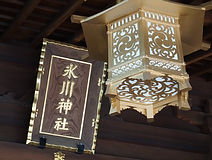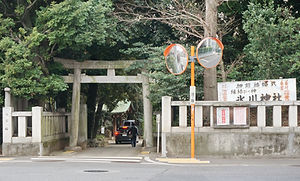普通の外にいくつかの著名な品質を持っている、と畏敬の念を起こさせるあるいかなるビーイングは、カミと呼ばれています。
Nearest station
Shibuya
JR, Keio, and Subway Lines
Tōkyō-to, Shibuya-ku, Higashi 2-5-6
東京都渋谷区東2-5-6
氷川神社
Hikawa Jinja
Home page: none
March 30, 2019
History
Often referred to as Shibuya Hikawa Jinja, In olden times it was known as Hikawa Daimyōjin and it served as the tutelary deity for the then Shimoshibuya and Toyozawa villages. Exactly when it was founded is unclear but it does seem to be quite old. According to a report dated 1605 written by the 100th chief priest of the Hosenji Temple (宝泉寺)—founded during the Kōnin Period (810-824) by the Buddhist priest Ennin—the shrine was established sometime in the first or second century A.D. when the legendary Yamato Takeru was on his Emishi subduing expedition. Susano-o was enshrined as its kami via the kanjō
Enshrined Kami:
Main
Inada-hime-mikoto 稲田姫命
From Merged Shrines
None
In-ground Shrines:
Itsukushima Jinja 厳島神社
Inari Jinja 稲荷神社
Akiba Jinja 秋葉神社
Hachiman-sha 八幡社
Annual Festival: September 16



process. Hōsen-ji became the shrine's betto-ji. In 1713 it officially informed the Bakufu that the shrine's origins were unclear, and, compounding the unclarity, a fire which broke out in the temple in 1782 destroyed many of its records. The shrine was largely rebuilt in 1938 and emerged undamaged from WWII .
Description
Slightly over 1 km away from Shibuya Station. Quite possibly the oldest shrine in Shibuya-ku. One of both The Seven Edo Hikawa Jinja and The Three Edo Suburban Sumo Jinja. There is a small park inside the shrine grounds in which the ring is preserved; tournaments were held annually on September 29. This shrine is spacious and while "well-wooded" may be something of an exaggeration there are many trees within its grounds and it is a pleasant place to relax amidst the general hubbub of Shibuya. For me the most interesting aspect of the shrine are the two sets of two in-ground jinja, Akiba and Hachiman, Itsukushima and Inari the latter two with full complements of, respectively, koma-inu and kitsune.
(Click on images to expand them)


































